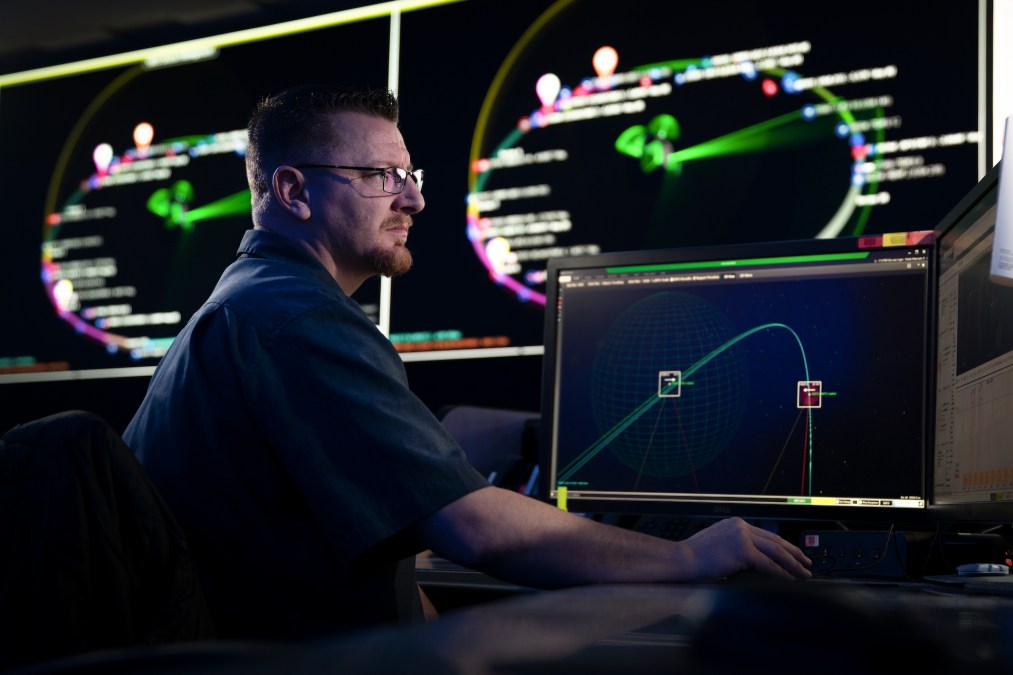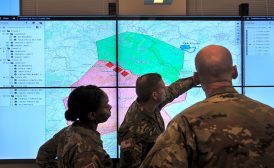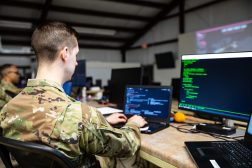DOD has not ‘adapted’ to strategic competition yet, according to a prominent think tank

A new report from the Atlantic Council argues the Department of Defense must adapt its thinking and approach to technology as a means of deterrence in order to succeed against myriad adversaries in an increasingly complex world.
The geopolitical environment has significantly changed from the Cold War and the post-9/11 counterterrorism campaigns. The current landscape involves multiple sophisticated adversaries seeking to gain regional and global supremacy by simultaneously subverting U.S. influence, the authors of the new report write.
This is often done through so-called gray zone operations, which exist below the threshold of armed conflict. Traditionally, the U.S. has viewed conflict in binary terms of war and peace while adversaries view it on a constant continuum, experts say.
While the DOD has begun to recognize this reality — even publishing a joint concept for how to compete in this gray zone — the Atlantic Council study argues the DOD has not put its money where its mouth is.
The Pentagon has identified China, and to a lesser degree Russia, as its top strategic competitors.
“Strategic competition requires a significant mindset shift to effectively harness the effects of multiple instruments of power in a global, multi-domain, and coherent manner. DOD doctrine acknowledges this, but the department and joint force have yet to fully operationalize it,” the report authors write. “An expanded competitive mindset will allow the joint force to view competition not as an inevitable march toward future conflict, but rather as a persistent effort to gain and maintain positional advantage across all domains.”
The U.S. military needs a better targeting approach across theaters and domains, they say. Advancements in technology, such as cyber, allow an actor to collect information and actually conduct effects operations across traditional geographic boundaries.
In order to posture itself for success, the Pentagon must meld existing frameworks for joint targeting with a model that “places a premium” on gaining placement and access within a region, per the report.
“[A] new competitive mindset requires broadening the joint force’s tool kit beyond traditional military effects,” the study states. “Fusing kinetic and non-kinetic fires is critical not only from a deterrence perspective but also, more significantly, to enable victory in armed conflict.”
In fusing these capabilities, the joint force must also take advantage of capabilities across government and allies, not solely the DOD apparatus. This means combining diplomatic channels with intelligence and military capabilities to not only create a more holistic picture of adversary efforts in a region, but also to identify and assess potential targets.
Data will be absolutely critical in the next fight and certainly within the competition sphere, the authors argue.
“The joint force’s ability to leverage data at speed and scale, predicated on its adoption of emerging technologies such as artificial intelligence (AI), enables this framework for targeting and effects generation,” the report notes. “The DOD must build a robust and extensive data architecture, fusing private sector data with government data, and build frameworks and standards to harness it into actionable information. Data fuels everything from access and understanding, to options, targeting, and analysis, to predictions and recommendations.”
However, this data must be accessible at the appropriate echelons in order to be acted upon.
One of the key aspects of the competition arena is the ability to shape the environment ahead of a potential conflict. While the ultimate goal is deterring war before it occurs, in the event a conflict breaks out, the joint force must be postured to understand where the enemy’s assets are and have targets pre-developed to act upon immediately to ensure decisive victory.
“Shaping the environment is crucial to securing a position of advantage across multiple domains left of conflict. In the context of targeting and effects generation, activities to shape the environment must center around closing critical operational and intelligence gaps associated with a prioritized target list tied to operational plans. These activities are intended to enhance precision and lethality of engagement and shorten the kill chain once armed conflict begins,” the report states.
This extends to “non-kinetic” weapons as well, especially with countless digital targets the adversary may have. Capabilities such as cyber tools, electronic warfare and directed energy systems are typically described as “non-kinetic” weapons in DOD parlance.
“To hold millions of virtual targets at risk instantaneously necessitates significant preparation of the environment,” the authors write. “Indeed, a multiyear campaign built around access and understanding — by, with, and through regional allies and partners — may be necessary to simply gain access to the right adversary networks. Development and installation of cyber capabilities would be executed in parallel, with the associated development and intelligence gaps feeding back into the overall campaign approach.”
The other aspect to “stacking the deck” before conflict, as the authors phrase it, is developing new capabilities. However, it’s not enough to merely have the best technology, they note. An effective combination of technologies, tactics and training are needed.
“Technology development must be informed by an understanding of the operating environment, the capabilities of adversaries, and the nature by which the joint force executes operations,” the report states.






